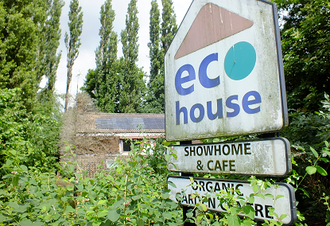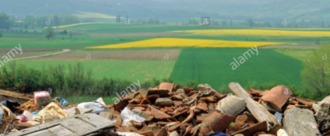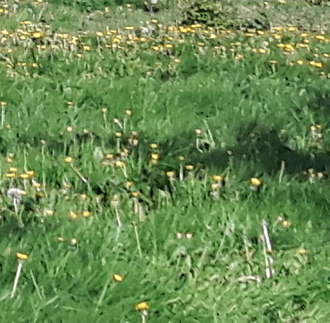-
Save Our TreesThe trees are an important area for the environment, for the birds nesting and roosting in them. The trees form a magnificent canopy over the village green, an amenity used by the general public and also by photographers especially for weddings and Christenings. The area is extremely attractive and sets off the approach to St. Peter's Church.255 of 300 SignaturesCreated by Gweneth Thorp
-
Protect green space in LutonLuton is a small borough with a large population and one of the youngest populations in England --there needs to be a good amount of green open space for the enjoyment of all the residents in Luton. A large park (Wigmore Valley Park) is currently under threat of industrial development because it is close to Luton Airport. Luton currently has less than 50% of the recognized green open space for a town of its size and population.236 of 300 SignaturesCreated by Lawrence Patterson
-
Make it compulsary for dog poop bags to be biodegradableSome dog owners collect the dogs poop in a bag and dispose of inappropriately which unpleasent and is worst than not picking up the poop as the bag will remain for decades. Biodegradabale bags would be better for the enviroment if disposed of correctly or incorrectly.13 of 100 SignaturesCreated by Kevin Kennedy
-
Abandon the sale of the EcoHouse and heritage school in Western ParkWe, the Leicester public, are rapidly losing our green spaces – 6 acres of allotments off Saffron Lane were sold last year. The Western Park golf course has been closed down, Oadby golf course is for sale as are 14 acres off Loughborough Road, 5 acres on Abbey Meadows and now 5 acres in Western Park. Without parks, where will our children learn to play football or ride bicycles? Will they have to pay an entrance fee? Where will we walk our dogs and breathe unpolluted air? We see our heritage privatised or gentrified, too. The Castle and its gardens, Wyggeston House, the City Rooms, the Pavillion in Western Park, Belgrave House, Braunstone Hall and now the rare surviving example of an Open Air School in Western Park. Heritage City, accessible only to those who can afford it? We say enough! Both the EcoHouse and the Open Air School are our heritage. Both were shining examples of progressive thinking, highlighting 'the way forward' in terms of public wellbeing and the health of the planet that sustains us. Clean air is a human right. The Council has Clean Air and Low Carbon policies. We want to see these put into practice - meaning the sell-off and building up of our green spaces has got to stop. As things stand, 20 houses will be constructed on the EcoHouse site. The heavily used carpark will be lost. Years of building upheaval will follow, as will the permanent transfer of our assets and park land into private pockets. This short term thinking - papering over the cracks of outdated 'economy first, people second' politics - is harmful to our rights and to the long term future of our city. Leicester City Council have no management plan for Western Park beyond 2016. Does this bode the sell-off of all of our beloved park? We, the people of Leicester, say no more selling off of our crown jewels! Our Mayor has pledged to build strong, resilient communities – how will he do this, if no space remains where those communities can come together? There are long term alternatives that put people and the future of our city before short term cash. Leicester City Council, put your pretty policies into practice, please.1,339 of 2,000 SignaturesCreated by Michaela Smith
-
Don't sell plants treated with bee-harming pesticidesHarmful pesticides are killing our bees at an alarming rate. They're currently banned across fields in Europe, but many garden centres are still selling flowering plants that have been treated with the killer pesticides. I'm a beekeeper, and I was really pleased this week when B&Q announced that from Feb 2018 they are going to stop their suppliers from using these pesticides on any of the flowering plants they sell. There's no reason that other garden centres can't introduce the same rule to protect our bees.137,278 of 200,000 SignaturesCreated by Martin Corbett
-
Scrap Trafford Green Bin TaxTrafford Council have stated that from the 5th June 2017 residents will be charged extra if they want their garden waste collecting. This is a highly objectionable move by the council, which is completely unjustified, undemocratic and particularly unfair on the frail and disabled, as they would struggle to transport rubbish to their local tip. Residents are already funding waste collection via council tax, so where does it stop - extra charges for rubbish collection, education, environment, sewage, policing, fire service, housing, transport and health? Sign and stop it now!3,505 of 4,000 SignaturesCreated by Phil Watson
-
Save our trees on 'Green' lanesThe council ignore resident concerns and is intent on pressing forward despite the transformation of our Winchmore hill into an ugly, congested, concrete jungle with decimated natural beauty and failing business. Enfield council presented false statements and visual plans of green lanes in their 'consultation for the cycle lane scheme - on the drawings no mention was made of tearing up and ripping out ten mature trees along our green lanes to date - and more to come.The residents of Winchmore hill did not agree to the replacement of beautiful mature trees with grey slabs of concrete - 'improving public spaces ' in the council's words. No effort has been made to protect the trees at all despite claims to the contrary . Worryingly letters have been put in local communications to inform residents of more trees 'necessary' to be removed . These were not presented as needing removal in the 'consultation' plans. We live in Winchmore hill because we chose to live amongst greenery and historical mature trees.472 of 500 SignaturesCreated by Maria Panayi
-
Support for formal Bridleways in Pelsall and RushallRoads are increasingly dangerous for the equestrian community with ever increasing traffic and speeding vehicles. It has never been more important to provide safe, off road riding for those who enjoy hacking out in our areas of natural beauty. Most landowners are understanding of their legal obligations to keep bridleways free from obstruction and provide suitable gates to provide access. There are no formal routes for the current equestrian community to safeguard their current pastime and access is threatening the informal existence of routes currently followed due to the installation of barriers to reduce off road biking nuisance. The equestrian community are proud of their links with the non-riding community who also enjoy and share some of the routes used whether it be for cycling or walking and wish to ascertain everyone's safety in the process.231 of 300 SignaturesCreated by Garry Perry
-
Save Our Community Spaces, MossleyThe recent threat to auction off some of Mossley's community spaces has revealed the urgency to gather support for these spaces, which once gone will never be replaced. Cosgrove Gardens, Greaves Street ( encompassing Mossley's community orchard and the car park at Cross Street ) were withdrawn from auction. Spring Street car park and gardens have also been withdrawn from auction and are in the process of being registered as a community asset. However, Tameside Metropolitan Borough Council will be reviewing all of these sites in the near future due to ongoing austerity that the council is facing. We are continuing to oppose the future sale of these public spaces and to ask that they be permanently removed from the list of land for sale so that these spaces can be continued to be enjoyed by the Mossley community. If you are interested in joining SOCS and supporting this vital work (in any way small or large), or just keeping up with what’s happening in your town, please contact: [email protected] or via Facebook at https://www.facebook.com/groups/669414999916345/346 of 400 SignaturesCreated by Rachel Downham
-
Stop The Landfill and Protect an AONBAll residents of Harcombe valley, Lyme Regis, Uplyme, Charmouth and Axminster will have to deal with: Sound pollution - the field is on top of a valley and sound carries very clearly, driven by breezes from the coast. 30 lorries with reversing beepers and a bulldozer up there 6 days a week will impact everyone who lives in the valley considerably. Traffic - traffic in our area already reaches congestion levels during peak periods and holiday times. Traffic into and out of Lyme Regis can become untenable. Lorries are advised to go via Charmouth roundabout but we have no faith that there will be adequate policing of this stipulation. Dust/Mud: this scale of delivery of material and waste will result in mud trails being left on the A3052 which is the main route into and out of Lyme Regis on the East side. If the weather is warm and dry, we can only imagine the scale of dust that will be generated, dust that will blow directly across the valley over nearby residents. Land slippage: it has been assessed that in order for this scheme to achieve its stated aims: ‘to level up the playing surface of this driving range’ – parts of the bottom edge of the field in question may well be raised 20-30 feet. This is a very large quantity of material on a significantly steep slope. Since there was a well-known major land slip in the field literally next door to this some years back, it seems entirely justified to have deep concerns about the safety of this scheme – especially for those living underneath it. RUN-OFF – despite all claims that the material being dumped here will be inert and completely harmless, there are plenty of precedents that can be found to show similar dumping schemes can let their standards slide. Before anyone has noticed unwelcome material is being included.. ..and the resulting run-off after rain, affects the grazing nearby, and the stream which is exactly beneath this site. Who will be policing this aspect? AONB – it hardly needs stating that this area is universally noted for its peace and beauty. We only have to witness the huge numbers of people who travel from far and wide to visit the charming town of Lyme Regis and the coast around it, at all times of the year. Does it seem in any way sensible to carve up a large field right next to one of the main arteries to this stretch of coast, and have an unending stream of huge, noisy lorries dumping waste into it 5 years? GENERAL We believe that this site has previously had an application made to provide shelter and floodlighting for the Driving Range. This was apparently denied because of the light pollution it would cause to residents across the valley. I’m sure we’re all grateful that it was denied.. ..but this adds to the amazement that a certain amount of silent lighting would be denied, and yet an unending disruption of trucks, bulldozing, dust, mud, noise and traffic should even be considered appropriate! Overall, even if your decision turns out to approve a scheme that only benefits the proposers, we have very little faith that all the various aspects that will need constant monitoring during the proposed period, will be sufficiently monitored. Please visit this site and take a good, long look at its negative impact on a large number of people in this area, before you decide to condemn us to years of disruption. The residents of Harcombe valley, Uplyme, Lyme Regis, Charmouth and Axminster196 of 200 SignaturesCreated by Anna Baréz-Brown
-
STOP CHOPPING OUR TREES DOWNLeabridge Road is ugly and filthy and the only part that makes me smile is that group of trees as I go home. Already 5 trees across the road have been chopped down and will not be replaced. There will be next to none mature trees left along the grey, dirty road. They will be replaced by nine small trees evenly spaced all around the new store totally destroying the only wall of green foliage along Leabridge Road. I don't understand. We go on about air quality/ pollution, unhealthy living environment so on and despite the very well known fact that trees not only combat pollution but add a sense of well being into our lives, we chop down the trees. Doesn't make sense. Please publicise it and help stop this nonsensical destruction.301 of 400 SignaturesCreated by genevieve tester
-
PROTECT GREEN PUBLIC OPEN SPACES, HORLEY, SURREYThese 2 pieces of green situated between Landen Park and Arne Grove in Horley, Surrey, were designated as 'PUBLIC OPEN SPACES' when the housing estate was designed and built in the early 1970s. These green spaces are used and enjoyed every day by residents of all ages for activities such as walking, dog walking, cycling and playing. They have also been used for community celebrations such as for the Queen's Jubilees. The green areas provide a vital habitat for local wildlife including birds and bats. The space creates a visual break for residents, and these areas have been an important factor in many residents' decision to move into the estate over the last 40 plus years. This land is now being threatened with development. As residents we are already being impacted by the huge development to the north-west of us at the Westvale Park site. Building on these areas would bring even more traffic to two already crowded cul-de-sacs, creating risks for local children who play and walk these streets. For the health, well-being and sustainability of community and family life, and for the protection of local wildlife, we must protect these precious green spaces.174 of 200 SignaturesCreated by Philippa P
Hello! We use cookies to improve your experience by providing insights into how the site is being used. Find out more.










.jpg)

